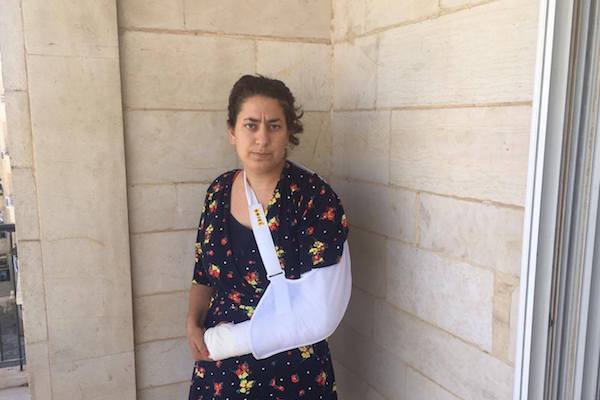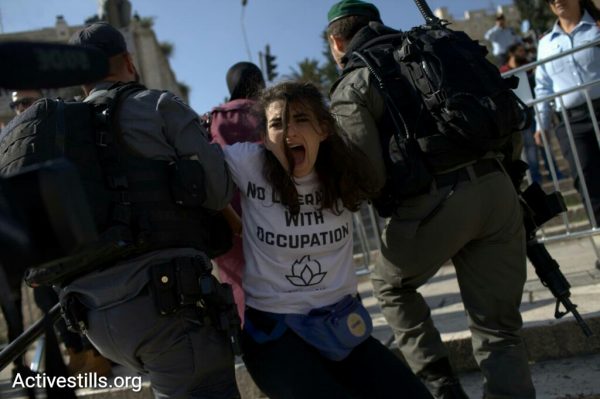Where was the Israeli Left when the army tore down a joint Palestinian-Jewish protest camp, or when the police broke the arm of a Jewish American activist in Jerusalem?
By Amitai Ben-Abba

during a night raid on the Sumud Freedom Camp, Sarura, West Bank, May 20, 2017. (Ahmad al-Bazz/Activestills.org)
Freedom Camp in Sarura, South Hebron Hills. On May 29, large army and Border Police forces raided the little that was left in Sarura after the previous raid the week before. They confiscated mattresses, a generator cable, a car belonging to Fadel Aamer (one of the landowners), two tents, food, and water bottles. They also detained three Palestinian activists, one of them Aamer’s son, confiscated their phones and destroyed their protest banners.
Fadel Aamer returned to live in Sarura on May 19, accompanied by 300 activists — the majority of them American Jews. Aamer was expelled from Sarura in 1997 at the height of a long process of dispossession, which began in the 1980s with settler violence and abuse by the state. Alongside other Palestinians from the South Hebron Hills, Aamer continues to maintain a protest tent until he is allowed to return to his land with his children and grandchildren.
While thousands got together in Tel Aviv’s Rabin Square to demonstrate against 50 years of occupation, I headed to Sarura for a night shift. With the notoriously violent settler outposts of Havat Maon to our north and Avigail to our south, I expected little sleep. Yet the atmosphere was calm and hopeful. The first night of Ramadan. Over a dozen teenagers from the nearby town of Yatta came to sing folk songs and dance dabke. Others belong to the Aamer family or are from the nearby villages. Then there are the diaspora Jews, from places as diverse as Morocco, Australia, and Switzerland. And myself, the only Jerusalemite, staring in wonder at a hidden world full of campfire and baklava, as if only I could see it.
The Arabic word “sumud” means steadfast perseverance. And indeed, as I looked around, I saw the same faces from the various villages in the South Hebron Hills, sitting together around the campfire and reminiscing over the large demonstration in Susya a few years ago — dear people whom I know from many years of anti-occupation activity. They joked about the attempt to tear down the protest tent. It turns out that they succeeded, through nonviolent means, to protect the large shade canopy from confiscation and extricate an activist from the hands of the police.
Fadel’s face became serious. “This is where I will die,” he said, revealing his bandaged leg, and the bruise between his eyes, evidence ofthe violence he encountered. “When they tried to take the tent, I told them to shoot me. Enough, I cannot leave my home, they will need to kill me in order to remove me from here.” And yet, Fadel looked happy — the kind of happiness that emanates from a man who stands up for what is right.
Where was the media?
The message that army forces were making their way toward the protest camp came suddenly from friends in the village of A-Tuwani. The activists quickly hid the canopy and the generator. An army jeep approached, circled around us, and left. The lights went down, revealing the nebula of the galaxy spiraling in the sky above. A breeze bore promise of a cool night. A jackal cried from the Mountains of Moab. But with all the beauty around us, I felt a kind of sadness. Israeli activists were sorely missing from the camp. Only five were here during the raids. Hebrew news outlets, aside from Local Call (and the settler outlet HaKol HaYehudi, which warned of a new “anarchist outpost causing unrest”) did not report on the return to Sarura.

Sarura wasn’t mentioned in the large protest in Tel Aviv. Left-wing parties that knew of the action, such as Meretz and Hadash, refrained from talking about it or sharing our posts on Facebook. The Sumud Freedom Camp has the potential of being an example of co-existence and joint struggle for a just peace. But Israelis refuse to recognize this.
I am not the only one who noticed this. Israeli activists from the group Free Jerusalem, as well as Americans from the anti-occupation group IfNotNow, who organized the direct action at Damascus Gate on Jerusalem Day, felt similarly. Every year, nationalist Israelis hold a “March of the Flags” through the Muslim Quarter of the Old City, destroying Palestinian property and chanting “death to Arabs.” We formed a human chain at the entrance to Damascus Gate, and once the police tried to remove us, we immediately sat down, linking our arms and legs. The police stopped, confused, and I was filled with joy.
There is no sweeter feeling than the one when you know you are doing the right thing. Settlers called on the police to shoot us. Palestinian passersby joined the human barricade. Americans sang songs of peace in diasporic Hebrew. The joy was short-lived, however, and the police ripped me from my small piece of paradise on the floor. But in their characteristically unprofessional way, they threw us nearby without preventing us from going right back to the pile of activists, sprawling on the floor. That was how we blocked the racist march for an entire hour.

Our direct action was seen by many as breaking the barrier of fear from the the fascist right wing. The police broke the arm of an activist, who then had to get surgery. Aside from that, the action was successful as per the parameters of civil disobedience. The first round of marchers encountered resistance, the state showed us all how it violently abets the march, and the action was given air time in Israeli, Palestinian, and international media — including right-wing outlets. The American Jewish Left backed the action, with calls of support from organization as varied as the boycott-supporting Jewish Voice for Peace and a condemnation of the police’s violence by the moderate J Street. But the establishment Israeli Left stubbornly insists on placing the emphasis on naive protests — a ritual that has repeated itself for fifty years, creating a veneer of democracy. Why?
Swallow your pride and join the struggle
I turned to representatives from “Peace Now” and “Standing Together” (I have yet to received a response from Hadash), and asked why they decided not to join the action in the South Hebron Hills, as well as their silence regarding the activist who had her arm broken. Peace Now Executive Director Avi Buskila told me that he “could understand the effectiveness of civil disobedience,” but that he “does not connect as much to this approach,” since it means that the “channel of democracy no longer works.” Buskila says that this is his personal opinion, and that Peace Now does not deal with this issue, adding that he does not “see a situation in which one should refuse and break the law.” As an activist in Ta’ayush and the brother of a jailed conscientious objector, I cannot help but recognize that those same claims are made by soldiers in the West Bank who are just following orders.
Standing Together, which organizes joint Israeli-Palestinian demonstrations in the West Bank, responded that “the violence that was used against the activist in Jerusalem is enraging, as is the behavior of the police vis-a-vis those who wanted to use their right to protest against a racist and inciting march. As an organization of activists who lead a number of struggles for peace, equality, and social justice, w supported the protest against the march, and even organized a demonstration that included hundreds of activists from the West Bank. We received the information on the injured activist late, and of course we view violence against political activists with great severity, even if we do not publish a post about it on our Facebook page every time it happens.”

It seems as if an American activist’s broken arm simply does not merit too much attention. There is a sense of condescension toward international activists in general. As one of the organizers of the protest at Damascus Gate, I can state that this condescension is not only unnecessary, it is foolish. There is much to learn from American activists. Their media work was professional, with press releases ready to go and social media presence that reached hundreds of thousands of viewers.
On a strategic level, it is my impression that IfNotNow has a vision and an achievable goal of shifting the Jewish American community against the occupation in the next five years. They refuse to negotiate behind closed doors and have decided to wage their struggle publicly, out of an understanding that changing public opinion will also change institutional behavior. What kind of vision does the Israeli Left offer against apartheid? Herzog? Lapid? Kahlon? Until we put our resources into into empowering activists on the ground, we will not change reality.

Sumud Freedom Camp could be a starting point for activists who want to do more. Every canopy and water bottle in Sarura, every piece of property that that can help the people of the South Hebron Hills live on their land, is a threat to the Israeli forces. In this scenario, solidarity activists can have a huge impact. We do not need to expose our bodies to violence — it’s enough to simply come. If there is one thing I learned from my activism in Ta’ayush, it is that our presence in and of itself makes all the difference between a situation in which soldiers violently expel Palestinians, and a situation in which Palestinians are able to access and protect their land. It is not too late to swallow our pride and join the struggle.
Meretz also offered a response:
The Meretz Party praises every civil action against the occupation, which joins the resistance led by Meretz in the Knesset on a daily basis, as it faces a destructive government that seeks to entrench the occupation and make it permanent. As we mark 50 years of occupation, there is a large, praiseworthy civil awakening around the issue. Meretz sent its representatives to various coalitions that have been established in the past months for the sake of joint actions of resistance against the occupation, and has responded and participated in every initiative that sought its support. Meretz never received any request from the organizers of the action, and thus it cannot be said that Meretz ignored these requests.
Amitai Ben-Abba is a writer and activist from West Jerusalem. He can be contacted via his blog.

